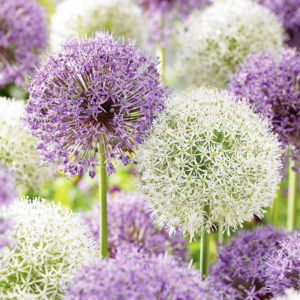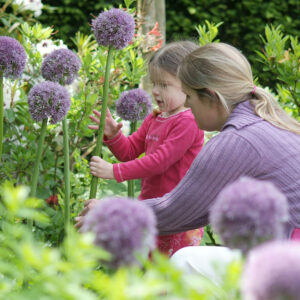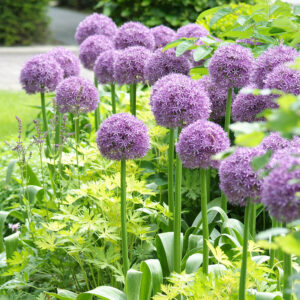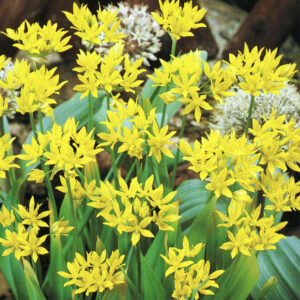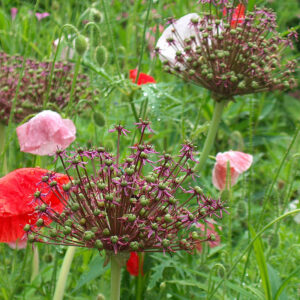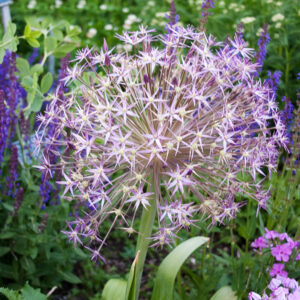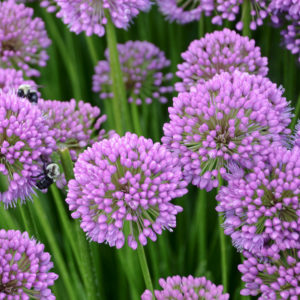Are they aliens or flowers? One could say a little of both. Growing allium in your garden will seem like you have flowers from a different world. The purple ball-shaped blooms of Allium giganteum are the most recognizable allium. They are, however, not the only allium in town. Alliums are standout flowers that provide blooms late in spring. Add allium bulbs to your garden for a taste of fun, whimsy, and unique out of this world blooms!
For gardeners new to growing allium this guide will help answer all your questions. If you have grown allium in the past this guide will help expand your knowledge on growing conditions as well as the different allium varieties available.
Allium Care and Tips
Who Should Plant Allium
People who want late spring to early summer blooms in their garden should consider planting allium bulbs. One of the nice features of allium bulbs is the range of hardiness zones where they will grow. Allium bulbs grow in hardiness zones 3-9. If you like unique and whimsical plants you should consider planting allium bulbs.
When to Plant Allium
Knowing when to plant allium bulbs will help you know when to buy allium bulbs. Plant allium bulbs in fall or early winter. Gardeners in cold climates will want to plant allium bulbs in September, October, or November. People in warm climates should plant allium bulbs in November, December, or early January.
Where to Plant Allium
Growing allium is easy. They don’t require much for growth and long-lasting blooms. Plant allium bulbs in an area that receives full sun to part sun. The sunnier the planting location the taller and larger blooms you will have.
When growing allium bulbs they do have one requirement that is absolutely necessary for success. Like many other flower bulbs allium bulbs demand that the soil has adequate drainage. If water pools in the area where you are planting allium bulbs, it will most likely lead to the bulbs rotting. Allium bulbs do not grow well in wet soil. Poorly drained soil is a common reason for allium failure. However, excessive freeze and thawing in the planting area can be detrimental as well.
Freeze and thaw cycles occur in climates that have periods of excessive cold and moisture mixed with warm spells. Planting allium at the proper planting depth and insulating with mulch is helpful to protect bulbs and roots from the effects of freeze and thaw cycles. Planting allium in a planter or above-ground container in a climate that has freeze-thaw cycles can be problematic. The bulbs will not have enough protection to survive the fluctuating temperatures, this can lead to the bulbs rotting.
How to Plant Allium
Plant allium bulbs at a depth 2-3 times the height of the bulb. Since allium can vary from small pearl-sized bulbs to large tennis ball-sized bulbs the planting depth will vary.
Allium giganteum are some of the largest allium bulbs; plant them 6-8″ deep. Moly Allium, Drumstick Allium, and Azure Allium bulbs are small – only 5/7 cm and should be planted 2-3″ deep. If you are unsure of the planting depth Holland Bulb Farms lists the planting depth on all of the allium bulb packages they sell.
Which side of the bulb should face up? In general, the pointed end of the bulb should face the sky. Allium bulbs are true bulbs. Roots form at the base and the growth comes from the pointed end of the bulb.
What To Plant With Allium
Allium bulbs that are planted in fall most often bloom in late spring. Plant bulbs and perennials that bloom in late spring to compliment and contrast the allium in your garden. Peonies, Bearded Iris, and Oriental Poppies are late-spring blooming bulbs that combine well with allium flowers. Perennials like Veronica, Salvia, and Butterfly Weed also bloom in late spring to early summer and they also look nice when planted with allium.
Bloom time is not the only characteristic to consider when planting your allium planting. Many varieties of allium have a strong geometric shape. In addition to the globe-shaped blooms, many varieties of allium are tall, growing over 4′ when mature. Tall varieties of allium such as Summer Drummer Allium, White Giant Allium, Allium giganteum, and Gladiator Allium are best planted in the back of a planting area.
Short allium varieties like Ivory Queen Allium and Drumstick Allium can be mixed into the front of a perennial bed. Planting the bulbs in groupings of 7-9 bulbs per planting hole will help create a full bouquet appearance.
Many allium varieties only grow 2-3′ tall. These mid-sized alliums like Star of Persia Allium and Purple Sensation Allium can easily fit into most planting beds.
Which Allium Have the Largest Blooms?
Big, bold, blooms are appealing for people growing allium bulbs. But, which allium varieties have the largest blooms? Although they aren’t the tallest of the allium, Star of Persia Allium has the largest diameter flowers. Star of Persia Allium blooms can grow up to 12″ in diameter.
Allium giganteum and Gladiator Allium are tall but also have large flowers. These varieties of allium blooms can grow up to 6″ in diameter.
Are Ornamental Onions and Allium the same thing?
Allium is the botanical genus for garlic, onions, chives, and also these flowering spring plants. Therefore, you may hear allium flowers referred to as ornamental onions. Alliums are members of the same family as onions; however they are grown for flowers and not food.
Allium Used to Deter Critters
Ornamental allium flowers have a slight garlic or onion scent. The scent is not overwhelming. Usually, the leaves have to be bruised to smell the garlic or onion scent by humans. However, animals such as deer, squirrel, chipmunks, and rabbits have stronger senses than humans and do not like the smell of garlic. Therefore, planting ornamental onions among your vulnerable flowers and bulbs can help to deter critters in the garden.
Are All Allium Grown from Bulbs?
We have mentioned growing allium bulbs an awful lot in this guide. However, not all allium grows from a bulb. Some varieties of allium grow from roots. Allium varieties grown from a bare root are typically planted in spring. Millennium Allium and Blue Eddy Allium are two examples of allium that are grown as a bare root perennial. Both the Millennium Allium and Blue Eddy Allium bloom a bit later in summer compared to the more common fall-planted alliums that grow from bulbs.
Turn Heads With Allium Flowers
Allium flowers in the garden often are show stoppers. Your neighbor may stop to ask what those large purple ball-shaped blooms are. Or the vase filled with the dried blooms of Drumstick Allium may be a great conversation starter at a family picnic. The range of flower sizes and shapes among allium blooms create interest while they are blooming, and even after. No matter the use in your garden, one thing remains true about allium flowers is they will turn heads!
P.S. For a fun DIY project with allium blooms try spray painting the dried allium blooms.


